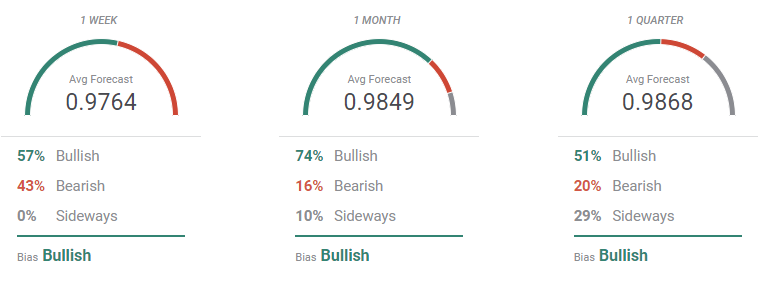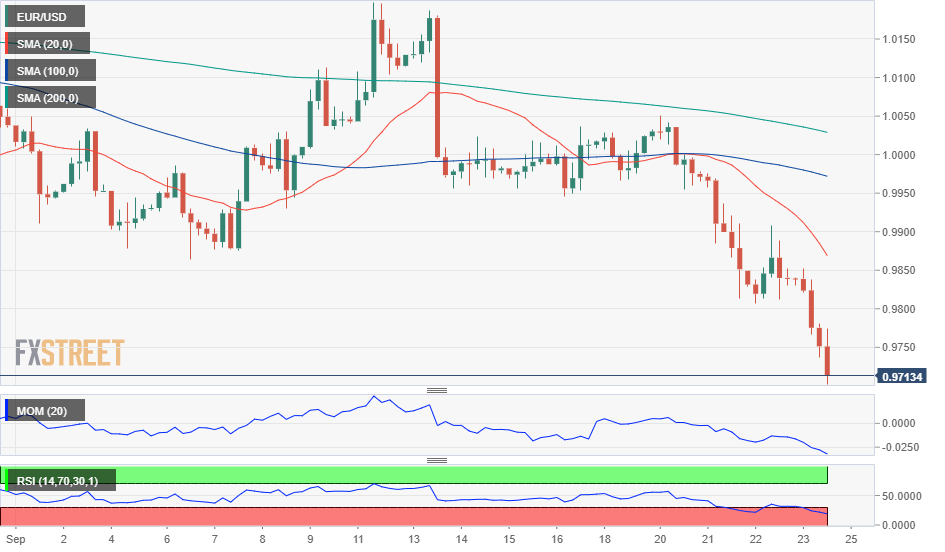- Central banks’ frenzy sent the dollar running amid risk aversion.
- The European energy crisis is likely to keep exerting pressure on EUR.
- EUR/USD keeps collapsing, and there is no bottom in sight.
The EUR/USD pair plummeted to 0.9706 on Friday, its lowest since October 2002, to end the week with sharp losses at around 0.9720. Financial markets were on hold throughout the first half of the week, ahead of first-tier events.
75 becomes the new 25
Central banks unwound volatility as several major entities decided on monetary policy. As widely anticipated, worldwide policymakers massively hiked rates to try to control inflation and bring it down to comfortable levels, regardless of the risks such decisions mean to economic growth. Recession fears overflew financial markets and spurred risk aversion, sending stock markets to multi-month lows and fueling the dollar’s demand.
The US Federal Reserve was the first to announce its decision, raising rates by 75 bps to 3.24%, a response to higher-than-anticipated core inflation in August. The central bank upwardly reviewed its inflation forecasts, seeing it coming down to 2% in 2025. At the same time, the Fed downwardly revised its growth estimates, seeing it just at 0.2% for this year but above 1% for the next three ones.
Chief Jerome Powell reiterated that he and his colleagues “are strongly committed to bringing inflation back down to our 2% goal,” as he expected “shelter inflation to remain high for some time.” Finally, he added that “no one knows whether this process will lead to a recession or, if so, how significant that recession would be,” although that would not stop the Fed from hiking further.
All in all, markets believe Powell and Co are preparing another 75 bps hike before the year-end. Such large rate hikes somehow indicate that policymakers are much more concerned with what they let show while also indicating they have no clear vision of how things will result.
But the Fed was not alone in its decision. The Switzerland National Bank also hiked by 75 bps, while the Bank of England turned a bit modest and triggered a 50 bps hike as Governor Andrew Bailey acknowledged that the United Kingdom is in recession, but the MPC decided that entrenched inflation outweighs the potential risks to the economy.
Meanwhile, and as the picture darkens in the European Union, market players lift odds for a 50 bps hike from the European Central Bank in October, while 75 bps are also on the table.
Moscow’s checkmate to Europe
The shared currency, in the meantime, suffered another setback as a result of escalating tensions between the EU and Russia. President Vladimir Putin ordered a mobilization to reinforce troops in Ukraine, calling 300,000 civilian reservists, as Moscow lost ground in the invaded territory. On Thursday, Putin menaced Western nations with nuclear war, should they continue to support Ukraine.
The escalation of the war exacerbates the European energy crisis as the winter approaches, which in turn, fuels chances of a longer and deeper recession. The European Commission has come up with different proposals to tackle soaring gas and electricity costs to households and industries ahead of the EU energy ministers meeting next September 30. The preferred solution is to detach gas from electricity prices and introduce a revenue cap on companies that produce energy without gas-fired plants. Meanwhile, different European countries are looking to bring back to life nuclear power to cope with the crisis.
Economic contraction steepens
Another reason for concern came from German data. According to the official release, the Producer Price Index in the country rose by 45.8% YoY in August from 37.2% in July, signaling price pressures are far from receding.
On Friday, S&P Global released the preliminary estimates of its September PMIs. European indexes showed that the economy slipped further into contraction, hurt by soaring energy prices. The German services index came down to 45.4 from 47.7 in August, its lowest in over two years, while the European Services PMI fell to 48.2, a 19-month low. Manufacturing output in the EU shrank to 48.5, leaving the Composite PMI at 48.2, its lowest in 20 months.
US figures, on the other hand, were quite encouraging, as business activity improved according to preliminary estimates. The S&P Global Manufacturing PMI improved to 51.8 from 51.5, while services output recovered from 44.6 to 49.3.
The upcoming week will kick-start with several ECB members speaking, including President Christine Lagarde. Hints on whatever the central bank could do next with the monetary policy will likely maintain EUR/USD volatile.
Among the most relevant macroeconomic figures scheduled for the coming days, we have the September German IFO survey on Business Climate and the October GFK Consumer Confidence Survey. On Thursday, the country will release the preliminary estimate of the September Consumer Price Index, which is foreseen up by 9.5% YoY. The EU will unveil inflation-related data on Friday.
The US will publish August Durable Goods Orders next Tuesday, and the final reading of the Q2 Gross Domestic Product, expected to be confirmed at -0.6% QoY.

EUR/USD technical outlook
After pausing in the previous week, the EUR/USD pair resumed its decline in the past one, and there are no technical signs it would soon find a bottom. The weekly chart shows two consecutive sharp declines after the pair tested the descendant trend line coming from this year’s high at 1.1494 on September 11. Technical indicators have turned firmly lower, and the RSI keeps heading south despite being at 26, reflecting extreme oversold conditions. The 20 SMA runs lower parallel to the trend line, over 500 pips above the current level.
For the upcoming sessions, the risk is skewed to the downside. The daily chart shows that technical indicators resumed their declines well below their midlines and that the RSI indicator approaches oversold readings. At the same time, the pair move further away from a bearish 20 SMA, currently at 0.9960. The longer moving averages keep heading firmly lower hundreds of pips above the shorter one.
The pair bottomed at 0.9686 in October 2002, the main support level and the primary bearish target. A break below it should lead to a continuation towards the 0.9600 price zone. The latter will be a tough bone to break, and once reached, a bullish correction could start developing. However, if the level gives up, there is not much in the way until the 0.9000 figure.
Former daily lows in the 0.9800/10 price zone provide immediate resistance ahead of the 0.9950 area. Sellers will surge if the pair spikes beyond parity, although an extension beyond 1.0060 could trigger stops and result in another leg north towards 1.0120/40.
EUR/USD sentiment poll
The FXStreet Forecast Poll for the EUR/USD pair indicates that banks and analysts were caught off guard after the pair’s collapse on Friday. Most polled experts aim for the pair to remain well below parity in the coming months, although the pair is currently at around 0.9700, the average targets fall above the current level. Still, the pair is expected to maintain its bearish bias in the coming weeks.
The Overview chart shows that the three moving averages have accelerated their declines. In the weekly perspective, most targets accumulate around 0.9600, with some bets of a corrective advance towards parity lifting the average. In the monthly and quarterly views, the pair is hardly seen advancing beyond 1.0100. What’s more relevant is that a potential test of the 0.9000 price zone is now on the cards.

Information on these pages contains forward-looking statements that involve risks and uncertainties. Markets and instruments profiled on this page are for informational purposes only and should not in any way come across as a recommendation to buy or sell in these assets. You should do your own thorough research before making any investment decisions. FXStreet does not in any way guarantee that this information is free from mistakes, errors, or material misstatements. It also does not guarantee that this information is of a timely nature. Investing in Open Markets involves a great deal of risk, including the loss of all or a portion of your investment, as well as emotional distress. All risks, losses and costs associated with investing, including total loss of principal, are your responsibility. The views and opinions expressed in this article are those of the authors and do not necessarily reflect the official policy or position of FXStreet nor its advertisers. The author will not be held responsible for information that is found at the end of links posted on this page.
If not otherwise explicitly mentioned in the body of the article, at the time of writing, the author has no position in any stock mentioned in this article and no business relationship with any company mentioned. The author has not received compensation for writing this article, other than from FXStreet.
FXStreet and the author do not provide personalized recommendations. The author makes no representations as to the accuracy, completeness, or suitability of this information. FXStreet and the author will not be liable for any errors, omissions or any losses, injuries or damages arising from this information and its display or use. Errors and omissions excepted.
The author and FXStreet are not registered investment advisors and nothing in this article is intended to be investment advice.
Recommended Content
Editors’ Picks

Gold hovers around all-time highs near $3,250
Gold is holding steady near the $3,250 mark, fuelled by robust safe-haven demand, trade war concerns, and a softer-than-expected US inflation gauge. The US Dollar keeps trading with heavy losses around three-year lows.

EUR/USD retreats towards 1.1300 as Wall Street shrugs off trade war headlines
The EUR/USD pair retreated further from its recent multi-month peak at 1.1473 and trades around the 1.1300 mark. Wall Street manages to advance ahead of the weekly close, despite escalating tensions between Washington and Beijing and mounting fears of a US recession. Profit-taking ahead of the close also weighs on the pair.

GBP/USD trims gains, recedes to the 1.3050 zone
GBP/USD now gives away part of the earlier advance to fresh highs near 1.3150. Meanwhile, the US Dollar remains offered amid escalating China-US trade tensions, recession fears in the US, and softer-than-expected US Producer Price data.

Bitcoin, Ethereum, Dogecoin and Cardano stabilze – Why crypto is in limbo
Bitcoin, Ethereum, Dogecoin and Cardano stabilize on Friday as crypto market capitalization steadies around $2.69 trillion. Crypto traders are recovering from the swing in token prices and the Monday bloodbath.

Is a recession looming?
Wall Street skyrockets after Trump announces tariff delay. But gains remain limited as Trade War with China continues. Recession odds have eased, but investors remain fearful. The worst may not be over, deeper market wounds still possible.

The Best brokers to trade EUR/USD
SPONSORED Discover the top brokers for trading EUR/USD in 2025. Our list features brokers with competitive spreads, fast execution, and powerful platforms. Whether you're a beginner or an expert, find the right partner to navigate the dynamic Forex market.
